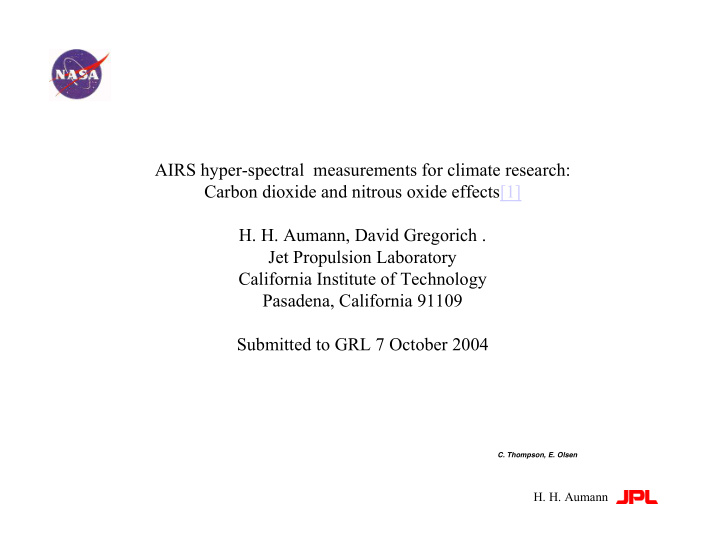



AIRS hyper-spectral measurements for climate research: Carbon dioxide and nitrous oxide effects[1] H. H. Aumann, David Gregorich . Jet Propulsion Laboratory California Institute of Technology Pasadena, California 91109 Submitted to GRL 7 October 2004 C. Thompson, E. Olsen H. H. Aumann
The AIRS Calibration Data Set contains for currently two years for all clear ocean spectra 84 key AIRS channels 15 AMSU channels interpolated to the AIRS footprint vis1,2,3 averaged to the AIRS footprint. matchup with RTG.SST lon. lat, sza, solzen, etc. about 100,000 spectra per day H. H. Aumann
Stability is better than 8 mK/year H. H. Aumann
H. H. Aumann
H. H. Aumann
H. H. Aumann
The annual trend and formal trend uncertainty estimates are d2229=64 ± 6 mK/year for day data d2229=52 ± 6 mK/year for night data The day/night average is 58 ± 8 mK/year We ignored the day/night shift of 100mK due to non-LTE at bt2388. There is an SRF shift of 0.5 ± 0.5 ppmf/year requiring a correction to d2229 is (+5 ± 5) mK/year. The trend to be explained, 63 ± 10 mK/year The trend can be explained due to the combination of the increase in the co2 and n2o abundance H. H. Aumann
bt2229 has sensitivity to n2o bt2229 gets colder by 37 mK/ppbv under tropical ocean conditions. The n2 column abundance of 318 ppbv, increasing at the rate of 0.6 ± 0.2 ppbv/year. The change in the n2o abundance produces an annual trend of 37*(0.6 ± 0.2)=22 ± 7 mK/year H. H. Aumann
bt2388 is much more sensitive to the co2 column change than bt2229. The net sensitivity of d2229 is 37 mK/ppmv co2 Based on Matsueda's co2 flask measurements the annual amount of co2 increase is currently 2.2+/-0.4 ppmv/year This annual increase in the co2 abundance results in a trend in d2229 of 37*(2.2 ± 0.4)=82 ± 15 mK/year. H. H. Aumann
observed after correction for SRF centroid 63 ± 10 mK/year combined effect of co2 and n2o is (82 ± 15)-(22 ± 7) = 60 ± 18 mK/year Observation explained. End of GRL paper. H. H. Aumann
The credible sensitivity to trends after two years of AIRS data is about 10 mK/year. We are now looking for other trends. Lapse rate at 5 km altitude, water column above 5 km altitude? , Is the onset of El Nino visible in the AIRS data in a correlation between WP warm pool and NE Pacific before it is detected by other means? H. H. Aumann
H. H. Aumann
H. H. Aumann
Recommend
More recommend